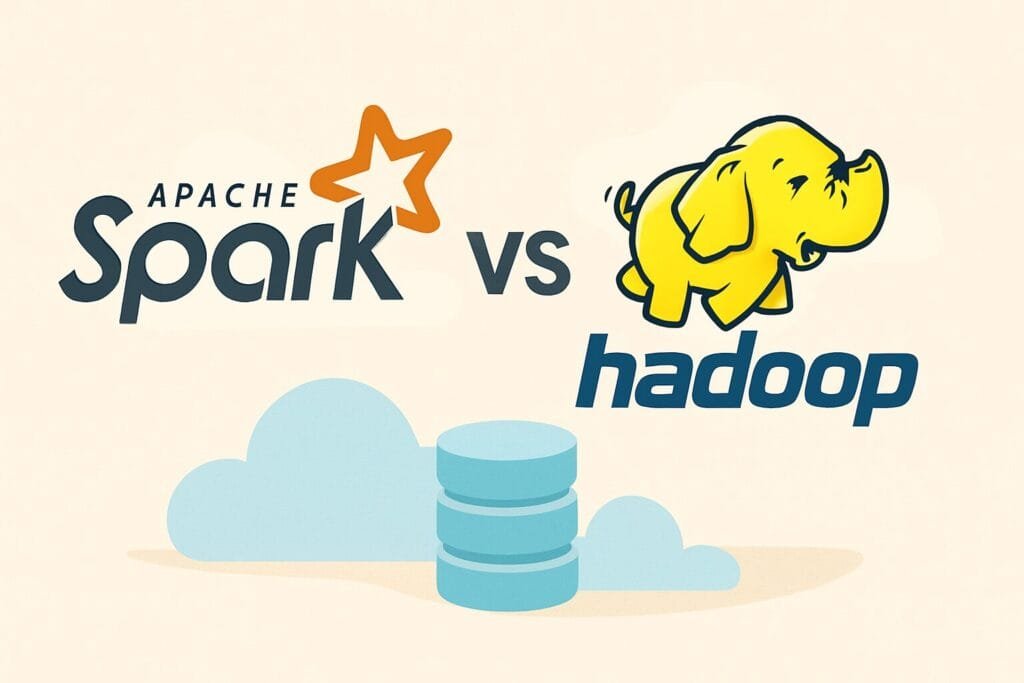When it comes to big data processing frameworks, two names dominate the discussion — Apache Spark and Apache Hadoop. Both are powerful open-source tools widely used in the data engineering and analytics world, but they serve slightly different purposes and use cases. If you’re a data engineer or aspiring to become one, understanding the difference between Spark and Hadoop is essential before deciding which one to learn.

What is Apache Hadoop?
Apache Hadoop is an open-source framework that allows distributed processing of large data sets across clusters of computers using simple programming models. It consists of several key components, including:
- HDFS (Hadoop Distributed File System): A distributed file system that stores data across multiple nodes.
- MapReduce: A programming model for processing large data sets in parallel.
- YARN (Yet Another Resource Negotiator): Manages and schedules cluster resources.
Hadoop became the foundation of many big data systems in the 2010s, enabling organizations to store and process petabytes of data efficiently.
What is Apache Spark?
Apache Spark is an open-source distributed computing system designed for speed, ease of use, and advanced analytics. Unlike Hadoop, Spark performs in-memory computation, which makes it dramatically faster for many data processing tasks. Spark supports multiple workloads such as batch processing, real-time streaming, machine learning, and graph processing, all within a single framework.
It provides APIs in Java, Scala, Python (PySpark), and R, making it accessible to a broad audience of developers and data scientists.
Key Differences Between Apache Spark and Hadoop
Below is a detailed comparison table to help you understand how these two technologies differ:
| Feature | Apache Spark | Apache Hadoop |
|---|---|---|
| Data Processing Speed | Extremely fast due to in-memory computation | Slower because it writes intermediate data to disk |
| Processing Type | Batch, real-time streaming, ML, and graph | Primarily batch processing (MapReduce) |
| Ease of Use | High-level APIs in Python, Scala, R, Java | Complex to code (mostly Java) |
| Fault Tolerance | Yes, via RDD lineage | Yes, via replication in HDFS |
| Machine Learning Support | Built-in MLlib library | External libraries needed (e.g., Mahout) |
| Data Storage | Uses memory + external storage (HDFS, S3, etc.) | Uses HDFS as primary storage |
| Real-Time Processing | Supported with Spark Streaming | Not supported (batch only) |
| Community & Ecosystem | Rapidly growing and widely adopted | Stable but slower community growth |
Performance Comparison
Apache Spark is known to outperform Hadoop MapReduce in most data processing tasks. In-memory processing can make Spark up to 100x faster than Hadoop when data fits into memory. However, Hadoop remains valuable for large-scale batch processing when the data volume exceeds available RAM.
Use Cases of Apache Spark
- Real-time analytics and dashboards
- Machine learning and AI model training
- Streaming data processing (e.g., Kafka integration)
- ETL (Extract, Transform, Load) pipelines
Use Cases of Apache Hadoop
- Storing and managing massive datasets
- Batch processing of log or clickstream data
- Data warehousing and archiving
- Processing unstructured data from multiple sources
Learning Curve: Spark vs Hadoop
If you’re new to big data, learning Apache Spark tends to be easier due to its modern APIs and integration with Python (via PySpark). Hadoop, on the other hand, requires more knowledge of Java and has a steeper learning curve.
Moreover, Spark’s versatility makes it a better long-term investment for careers in data engineering, data science, and machine learning.
Which One Should You Learn?
In 2025, the industry trend clearly favors Apache Spark because of its speed, scalability, and wide use in data analytics, AI, and cloud platforms like AWS, Azure, and Google Cloud. However, learning the basics of Hadoop is still valuable because Spark often relies on the Hadoop ecosystem for storage (via HDFS or YARN).
Recommendation: Learn Spark first for real-time and advanced analytics, and then explore Hadoop fundamentals to understand how distributed data systems work under the hood.
Integration Between Spark and Hadoop
It’s important to note that Spark doesn’t replace Hadoop completely. Instead, they complement each other. Spark can run on top of Hadoop’s HDFS and use YARN for resource management. Many enterprises use a hybrid approach — Hadoop for long-term data storage and Spark for real-time analytics.
Conclusion
Both Apache Spark and Apache Hadoop are essential technologies in the big data ecosystem. While Hadoop laid the foundation for distributed data processing, Spark represents the next generation — faster, more flexible, and more developer-friendly. For modern data engineers, mastering Spark should be the top priority, with Hadoop knowledge serving as a strong supporting skill.
To explore more about how these technologies are evolving, visit the official Apache Spark website.

